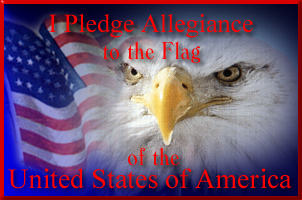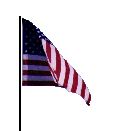


Flying The Flag
Often people have questions about the do's and don'ts of displaying the United States flag so I have done some research and compiled this page of flag etiquette. I hope you find it helpful and if there is something I have left out or needs clarification please mail me. Fly your flag regularly, but also correctly.
It is the universal custom to display the flag only from sunrise to sunset on buildings and on stationary flagstaffs in the open, but it should not be displayed on days when the weather is inclement (unless you have a storm flag). The U.S. flag may be displayed at night for special occasions when it is desired to produce a patriotic effect. It is especially important to display your flag on national and state holidays and other days proclaimed by the President of the United States. On Memorial Day, the U.S. flag should be half-staffed until noon.

What Not to Do
Never in any way should any disrespect be shown the U.S. flag.
The U.S. flag should never be dipped to any person or thing. Regimental colors, state flags, and organization or institutional flags are dipped as a mark of honor.
The U.S. flag should never be displayed with the union down except as a signal of dire distress.
The U.S. flag should never touch anything beneath it--ground, floor, water or merchandise.
The U.S. flag should never be carried horizontally, but always aloft and free.
Never use the U.S. flag as drapery, festooned, drawn back, or up in folds. For draping platforms and decoration use blue, white and red bunting. Always arrange the bunting with the blue above, the white in the middle, and the red below.
The U.S. flag should never be fastened, displayed, used or stored in a manner which will permit it to be easily torn, soiled or damaged in any way. Never use the U.S. flag as a covering or drape for a ceiling.
Never place anything on the U.S. flag. The U.S. flag should never have anything placed on it, or on any part of it, or attached to it, any mark, insignia, letter, word, figure, design, picture or drawing of any nature.
Never use the U.S. flag for receiving, holding, carrying or delivering anything. The U.S. flag should not be embroidered on such articles as cushions, handkerchiefs, and the like, printed or otherwise impressed on paper napkins or boxes or anything that is designed for temporary use and discard; or used as any portion of a costume or athletic uniform. Advertising signs should not be fastened to a staff or halyard from which the flag is flown.
When the U.S. flag is in such condition that it is no longer a fitting emblem for display, it should be destroyed in a dignified way, preferably by burning, privately.

Displaying the Flag Outdoors
The U.S. flag should be displayed on or near the main building of every public institution, during school days in or near every schoolhouse, and in or near every polling place on election days. Always hoist the U.S. flag briskly. Lower it ceremoniously.
On a Building: Hang the flag on a staff or on a rope over the sidewalk with the stars away from the building.
Over the Street: Hang the flag with the stars to the east on a north-south street or north on an east-west street.
With Other Flags: Hang the flag above any other flag on the same pole. If using separate poles hang all flags on equal poles. Hang the U.S. flag on its own right, hoist it first and lower it last.
In a Window: Hang the flag vertically with the stars to the left of anyone looking at it from the street.
On a Vehicle: Attach the flag to the antenna or clamp the flagstaff to the right fender. Do not lay the flag over the vehicle.
Half-Mast: This is a sign of mourning. Raise the flag to the top of the pole then lower it to the half way point. Before lowering the flag, raise it to the top again at the end of the day.

Displaying the Flag Indoors
Multiple Staffs: If you display the flag on a staff with other flags around it, place the flag at the center and highest point. Crossed staffs--keep the flagstaff higher and on its own right.
Behind a Speaker: Hang the flag flat on the wall. Do not decorate the podium or table with the flag. Use bunting for decoration.
In a Hall or Lobby: Hang the flag vertically across from the main entrance with the stars to the left of anyone coming through the door.
On a Casket: Drape the flag with its canton at the head and over the left shoulder of the body. Do not lower the flag into the grave. A flag is considered retired once it has been folded after a funeral.

Carrying the Flag
When Marching: Carry the flag on the right in any procession or parade. If there are many other flags, carry the flag in the front center position.
Carrying the Flag: Hold the flag at a slight angle from your body. You can also carry it with one hand and rest it on your right shoulder.

Saluting the Flag
Salute the Flag: When it is six paces from the viewer and hold it until the flag has passed six paces beyond. Salute the flag at the first note of the National Anthem and hold the salute until the last note is played.
When in Civilian Attire: Men remove hats and hold at left shoulder with hand over heart; without hat, place right hand, palm open, over heart. Women should place right hand, palm open, over heart. Face the flag or music.





